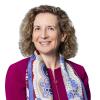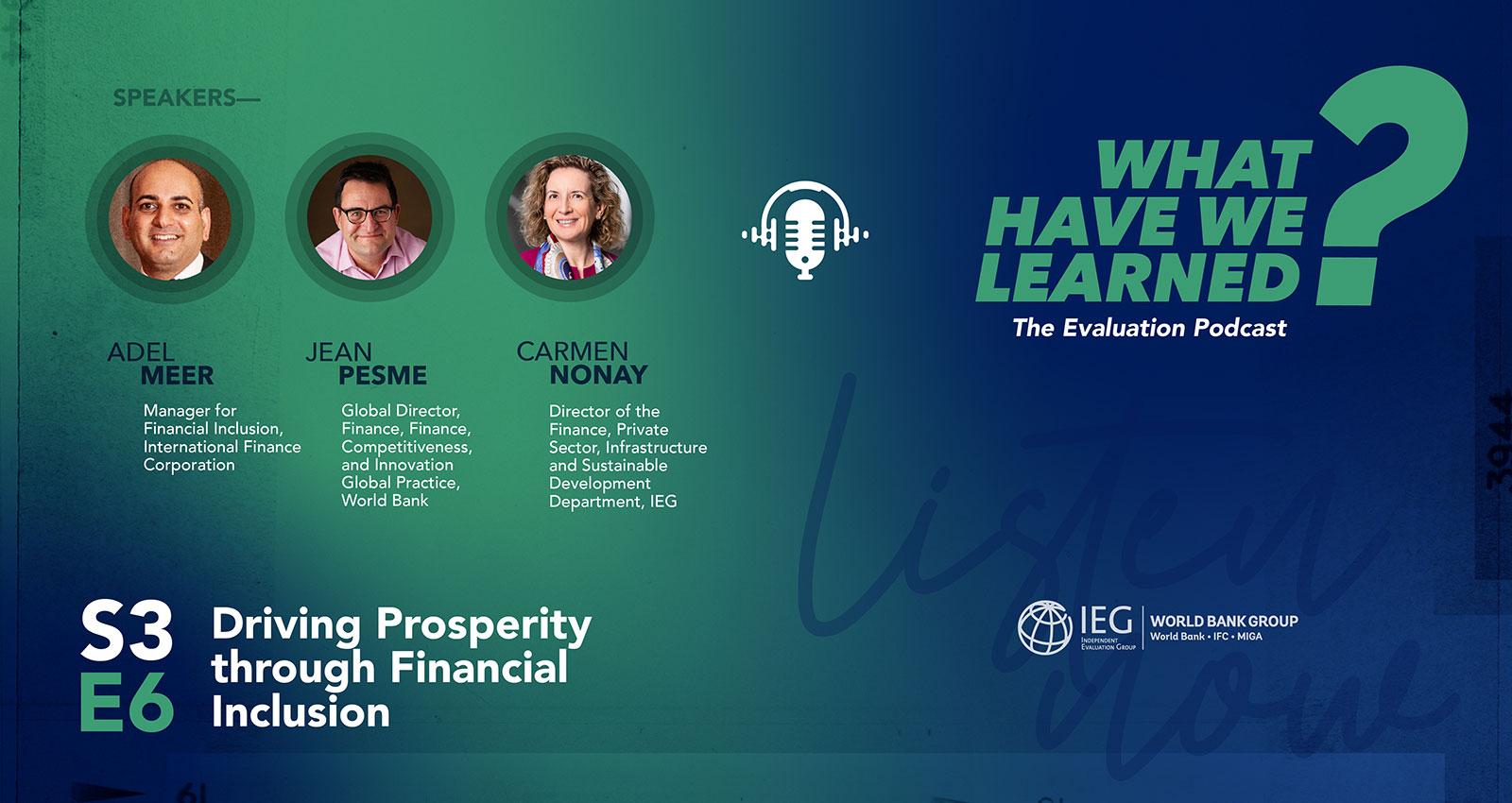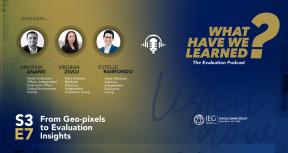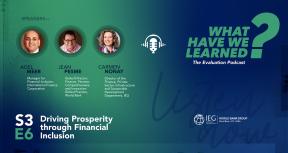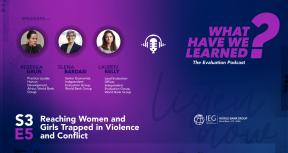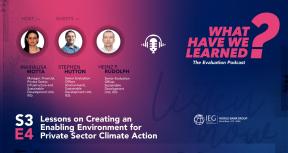Listen on: Apple Podcasts, or Spotify.
The use of financial services has enormous potential for poverty reduction and boosting shared prosperity. Improving financial inclusion is linked to at least 9 United Nations Sustainable Development Goals and is considered by the World Bank Group as a key enabler of its mission of creating a world free of poverty on a livable planet.
Accessing and using a financial account and services such as savings, credit, and insurance can provide significant opportunities for the poor. It enables them to save money securely, obtain financing for microbusinesses, invest in education and health, and mitigate the impact of unforeseen shocks.
This episode brings together two World Bank Group leaders spearheading financial inclusion efforts: Jean Pesme, the World Bank’s Global Director for Finance, in the Finance, Competitiveness, and Innovation Global Practice; and Adel Meer, International Finance Corporation’s Manager for Financial Inclusion.
Host Carmen Nonay, Director of the Finance, Private Sector, Infrastructure and Sustainable Development Department at IEG, moderates an energizing discussion on measuring outcomes, addressing the obstacles to access and usage of financial services, the challenges of reaching all vulnerable groups, leveraging technology and digital finance, and enhancing collaboration within the World Bank Group and with global partners.
TRANSCRIPT
Carmen Nonay: Financial inclusion can offer a path out of poverty and into prosperity for those most in need. The income of the people at the bottom of the economic pyramid is not only low, but also volatile because they rely on unpredictable jobs or on weather-dependent agriculture.
Having access to a financial account and benefitting from services like savings, credit and insurance has the potential to give the poor a chance to save their money safely, increase finance for their microbusinesses, improve investments in education and health, and reduce their vulnerability to shocks.
Hello and welcome. I am Carmen Nonay, Director of the Finance Private Sector Infrastructure and Sustainable Development Department at the World Bank’s Independent Evaluation Group, IEG. This is What Have We Learned? The Evaluation Podcast.
In today’s episode, we will be looking into financial inclusion, what it entails, and its enormous potential for impact. We will explore the evolution of the World Bank Group’s support to this critical agenda and share forward-looking lessons that can guide future engagements.
With us today, we have the World Bank’s Director for Finance in the Finance Competitiveness and Innovation Global Practice, Jean Pesme. Also with us today sharing his perspective of the private sector arm or the World Bank Group, we have the International Finance Corporation’s manager for Financial Inclusion, Adel Meer.
I would like to start by addressing the evolution from financial access to financial inclusion. How is the World Bank evolving to this critical next step towards financial inclusion? Let me start with you Jean.
Jean Pesme: It's a pleasure to be here and thank you very much for the opportunity to share our perspective.
With the new corporate scorecard we are going to shift from access to usage. I think that's a very important shift, but also looking at gender, both access and usage. We will need to work on two feet at the same time. Where there is still a very challenging access discussion, continue to push the envelope, and we have some countries in the world where most access challenge is still in place, so we will continue to push that.
And then for the countries where a lot of progress has already been made on access, then we need to turn our attention to the drivers of usage. Because what we want at the end of the day is what you describe in your opening, that the access to financial services and the usage of financial services is a better way to lead to prosperity, to help with the resilience. That's why we knew that you need to look at the range of financial services.
Carmen Nonay: Over to you Adel, how do you see the evolution from financial access to financial usage in IFC?
Adel Meer: For us, Carmen, it goes hand. It's not either or, it's and. What we're really emphasizing is through our network of financial institutions (FIs), who we primarily work with to get to MSMEs, we're trying to get an enhanced measurement metrics agreed upon so that over a period we can measure what they are doing with their clients.
That includes looking at the range of products they're offering their clients, the types of products they're offering their clients, the terms, the conditions. I think hand in hand with usage goes the responsibility of being able to offer financial services that are both affordable, are responsible, and are financially beneficial for the end user.
Carmen Nonay: My next question is on the limited data available on who is using and benefiting from financial services and what interventions deliver the greatest benefit as you were pointing out.
Over 90% of the World Bank Group's projects that IEG examined produced no information on outcomes. Without this information, it's hard to know whether the Bank Group’s engagement has helped poor households, micro enterprises, and other groups. How is the Bank Group addressing this knowledge gap on outcomes going forward?
Adel Meer: So, as we said, access is point one, usage is point two. But the critical metrics that we want to track and get much more data on is how does it improve the livelihoods of the people that are getting those financial services.
And that's where we're going to go from enhanced measuring metrics to case studies in select markets to impact assessments. Those impact assessments are going to be samples of portfolios that have benefited from financial services. We will ask what has that led to the livelihoods of that subset of SMEs? And then extrapolate from that. For us it's a question of data collection, analyzing that data, and looking at trends. Seeing where certain regulatory enhancements, certain product developments, certain investment interactions have led to positive outcomes and then replicating and scaling those.
Jean Pesme: There is work ongoing on better connecting the discussion and the work on financial inclusion and outcome. CGAP (the Consultative Group to Assist the Poor) for instance is leading some work. We are also leading some work. As part of the knowledge agenda in the evolution roadmap of the World Bank, we also want to use more impact evaluation, which is a way at the very specific and ground level to measure what are these connections.
In the context of the scorecard, we also want to be able to articulate much more in the context of theory of change, how you go from intervention, intermediary outcomes, and outcomes. Not just we have increased financial inclusion, be it access or usage, but also these are the end goals related to livelihood, related to poverty, related to jobs or resilience.
Carmen Nonay: You both have talked before about the connection with gender. I want to turn it to you, Adel. Let's talk about target groups. IEG's evaluation found that the number of financial inclusion projects with a gender component increased sharply in recent years.
However, support for other financially excluded groups has remained limited. These groups include rural communities, indigenous peoples, refugees, people with disabilities, and many others. How is IFC within the context of the World Bank Group continuing to address the gender gap without neglecting these other underserved groups?
Adel Meer: I think gender has been and will continue to be a priority for us.
The one thing we've looked at when you talk about excluded communities is the difficulty in categorization. It's not that we don't do enough in that realm. It's whether our partner Financial Institutions (Fis) have a category in their system to validate whether some borrower is of an indigenous ethnicity or whether they are from a rural versus urban designated area. They don't have those classifications. It's a little bit about building that classification criteria within our client companies or lenders and then tracking that information.
The other part is, and I think Jean referred to this, in some of those excluded communities or marginalized populations, access remains the biggest hurdle. Not so much usage. Over here, you're looking at getting them into the system and the definition of who is marginalized by which authority, what is the ID they're using to be documented or undocumented, that's quite a complicated situation.
We do have a program around forcibly displaced population. We've done a project with Venezuelan refugees in Colombia. We're looking at another project in Kenya with the Kakuma Refugee Camp. But it is also politically sensitive. Not every host country is willing to grant identification papers. Without identification papers, no regulated financial entity can grant loans to people that don't have proper ID against they which they can do AML, CFT checklists.
Carmen Nonay: Now I want to stay on the topic of reach, but this time I would like to address it from the angle of digital financial services as key instruments to extend financial solutions to the excluded and underserved. This was particularly evident during the COVID response when they need to reach those most at risk accelerated client demand for digital payment systems and services like mobile, digital payments, or e-commerce.
Two questions here for each of you. How is the Bank Group tackling upstream constraints to digital services like lack of infrastructure, weak regulatory frameworks, or low digital financial literacy? And how can the Bank Group secure the sustainability of services introduced during crisis like COVID?
Let me start with you, Jean.
Jean Pesme: Digital in the financial sector is a game changer. We had a joint paper with the IFC on the future of finance and how technology is changing the financial sector. What are the consequences and opportunities? You have opportunities, you have risk, but it is also leading to really rethinking how to think about financial services, who provides financial services but also how to regulate.
The second element that we are doing more on the financial sector side is really work with the public authorities on the Bank side to open the market. What we see is that introducing more competition and opening the market to new service providers has been a game changer.
We have a real-life test, which is pre-COVID, post-COVID. We saw the difference during COVID between the countries that already had in place mechanisms, that had opened their market; they were able to react much more effectively and faster to the situation than those would still have the older approach or more traditional approach. They had to catch up.
We are continuing that agenda. We still have a lot to do first because a lot of new things are emerging every day. A lot of new players, a lot of new financial product, but also because we are seeing development in terms of the regulatory firm.
This is a top priority for us in terms of making sure that the regulatory elements are in place, but also that there is that outreach to the customer with protection but also come with financial and digital literacy. We are trying to look at the whole spectrum, and in our case working with the public authorities to bring the best practices, test pilot new things, and then also adapt to the situation and how the markets are developing because it's very different from one country to the other. You need to balance between common principle and customizing the response to the local context.
Adel Meer: For us, it's looking at the supply chain, how the global supply chain has become much more efficient using these platforms. Looking at payments, remittances, making those services much more affordable and competitive. I think it has completely transformed the way people used to look at retail credit. Retail credit is no longer something that large traditional banks provide. I think more non-traditional service providers are in that realm.
The same way in e-commerce. The more you can get access to more markets, the more competitive your inputs become and the more attractive your output can become to other customers beyond your geographical realm. The opportunities for microentrepreneurs, SMEs, and households in less connected regions is huge with this expansion.
Now, it's exactly what Jean said. It must be responsible; it must be financially secure. So we've got to be very careful in terms of what are those guardrails that need to be created. In many cases the players are way ahead of the regulator. The regulator in some ways is playing catch-up. Because these entities that are providing financial services and lending products aren't taking public deposits, a lot of times they operate in a gray area where people are not sure whether they should be regulated by the central bank or by another line ministry.
It's getting some harmonization around what makes most sense to protect the end consumer but doesn't stifle the market. That's the balance that we're trying to reach.
Carmen Nonay: This is a very energizing and exciting discussion. I want to stress how important it is to have the two of you sitting here at the same table discussing these important issues. Jean, you are representing the World Bank and Adel, you're representing IFC. Finding and leveraging synergies between the World Bank and IFC is very important to advance this agenda.
Let me ask you, what are some key issues in which you are working together on this, and how is this cooperation and coordination producing better results?
Adel Meer: Look, for me it's a great partnership and maybe it's because it's the sector we're in. The financial sector is built on trust, and trust comes with the right level of safeguards, supervision, and support at the governance level.
That's where the bank is key, right? We can invest in private sector players, but if there's not the right regime in place, it's a highly risky venture and susceptible to fraud, susceptible to cybersecurity, susceptible to a lack of trust, which can completely suck out all the energy.
Now, there are markets where the regulatory framework is imperfect and we could continue to do an investment with a bank knowing that the regulations need to be worked on. But I have yet to see a market where we're not in sync. We know the direction we want to go. We may not be there at the same point, but the idea is there's coordination on distressed assets, there's coordination on data protection, on responsible finance, on many, many of the same topics.
Jean Pesme: Completely echo what Adel just said. I think it's very collaborative but also very intense discussion, both on the operational side so the teams in countries are coordinating and talking together so parties to learn from each other but also to see what's the potential. What's the part that needs enabling environment from the public sector, and what's the part where the private sector can then thrive?
But we also have discussion on the policy elements, so that's why I mentioned earlier that report on the future of finance because it was meant to bring the two perspective together. Because we see the evolution of the market from different perspective, and there was all that concern over regulation not stifling innovation. On the other hand, sometimes explaining the logic of the regulatory community on why you need to pay attention.
By doing this together, and I think through those internal discussions and debate, we also bring a fuller perspective but also a wider range of options because a lot of the principles are very common. The how you do it can you have a spectrum that is really large, and we want to continue to bring this range of opportunities to our client countries.
Carmen Nonay: This is very encouraging to hear. We know that financial inclusion is not only a financial sector matter. It intersects with social protection, climate resilience, governance, and other critical sectors that need to be considered. How are your teams connecting these dots within the World Bank Group? Tell us more about it, Adel.
Adel Meer: As you said, there are different elements that result in better livelihoods for the people in vulnerable countries and the underserved. And so financial inclusion for me is about broadening that net, right? Offering more in terms of protection, in terms of support, in terms of timely responsive products to the people that have been most impacted.
And so you have to connect the dots. You've got to look at the ecosystem, you've got to look the barriers of entry, you've got to look at who gets access, who doesn't get access. The ones that are getting access, are they getting the right suite of products at the right price? Can they afford it? And then ultimately, are they benefiting from it? Are they becoming more resilient to shocks? For that, I think the collaboration that must happen is at the macro level and at the micro level. At the global level within their organizations, but also at the country level. You've got to make sure that at the country level the teams are also aligned.
Jean Pesme: This is also what the World Bank is about, is that unique institution where you have colleagues and experts coming from a wide range of technical expertise and the ability to very easily bring that expertise to solve a very specific problem. I think that's one of the element also of this fact-based evidence-based approach to a problem that we are trying to solve is very important.
I'm going to take very specific example, which is about gender financial inclusion. Lots of the issues may be on the financial sector side, but you very quickly also identify issues that go well beyond the financial sector. Social norms may be a very important element. I think that's the part where you see the power of the World Bank, which is when you begin to dig a little more and do more diagnostic work on what are the key drivers, et cetera, when you get into social norms, then we have the ability to bring specialists from within the institution that may give us the context. What are the levels of the context, but also how from a financial sector perspective to either address or counterbalance these social norms. I think this is also inherent to some extent when we do it well to the structure of the bank and the structure of the World Bank Group.
Carmen Nonay: Let me follow this with a similar question to Jean, but now outward looking.
Adel has mentioned CGAP. Can you speak to the importance of mobilizing partnerships with the private sector to boost promising innovations or scale up sustainable businesses and with organizations like CGAP, or the Financial Inclusion Support Network, to increase reach and impact?
Jean Pesme: Yes, this is absolutely necessary. CGAP is a very good example. It has an existence on its own, its own at the World Bank. As Adel was saying earlier, it has also a very specific role. Some of the role is advocacy and influence, but some of the role is also the ability to do what I call research and development. It's a bit of thinktank piloting things. They can pilot things that we cannot do. It's way too complex, including in terms of decision-making process, etcetera for the World Bank to do some of this. We are doing things in country together sometime, but they're also using that evidence. And then the logic for them is once this evidence is there is to leverage us so that you go to scale.
We work with the UN, but also in parallel the Alliance for Financial Inclusion is part of the network. We are both recognizing the role and a competitive advantage if you can put that way, but also leverage each other, and this is one of the examples where we are doing that on the private sector.
This is the kind of bread and butter of everything that we are doing. I think part of the benefit also of the World Bank Group as a whole is that we go from those big discussion with standard setting bodies where we discuss financial inclusion with standard setting bodies to make sure that their standards are not impediment to financial inclusion. Very down to the macro level both with the communities, with the private sector, and our effort. It's not easy, and I'm not saying that we are perfect, to integrate all these pieces together inside the institution, but also with the partners is essential to our work.
Carmen Nonay: Anything else that I didn't ask that you would like to address?
Adel Meer: From my side, I think the emphasis going forward is going to be around vulnerability. It's going to be less around how many people you've got in the tent but have you made sure that the people living in the most vulnerable of regions and in the most vulnerable of circumstances have the right level of protection, have the right level of support, and have the options available to them ex-ante to withstand the shocks that are coming, primarily from climate change, from changing demographics.
Are there enough jobs available for them? Are there enough opportunities available for all genders, for all people who are looking for a better life.
Jean Pesme: Two things that we did not mention explicitly, and I'll stay on financial inclusion, not the broader financial sector. One is fragility context and the role of the financial sector in fragility in reducing the risk. The fundamental importance of the financial sector, and I have the payment system in mind, the importance of making sure that there is still a way to transact. That you can still make sure that those most vulnerable receive the support that they need, etcetera. I think that's something on which there is quite a bit of experience.
And then, to echo what Adel was saying on risk and vulnerability, there is the climate angle. There's been a lot of focus on the climate finance, on the macro side, sovereign financing, the transition, all the discussion on mitigation. We are seeing emerging all the discussion on helping in the context of vulnerabilities. Some of it is about financial protection insurance and the move to adaptation discussion. What does that mean to help SMEs to adapt to some extent? We are still working on that.
What I found very interesting on that discussion is that, and let me come back to one of the key recommendation from IEG, which is get to the bottom. What are the needs? What are the vulnerabilities? Therefore, what are the financial products that are going to help household individual SMEs to be better prepared in case of shocks and to arm them up to what's coming up? I think we are starting the work, but this is a fascinating agenda, a very complex one.
Carmen Nonay: Thank you, Jean and Adel, for joining us today. This is the end of the episode What Have We Learned? The Evaluation Podcast. Please stay tuned for the next one.
This Episode’s Featured Guests:
